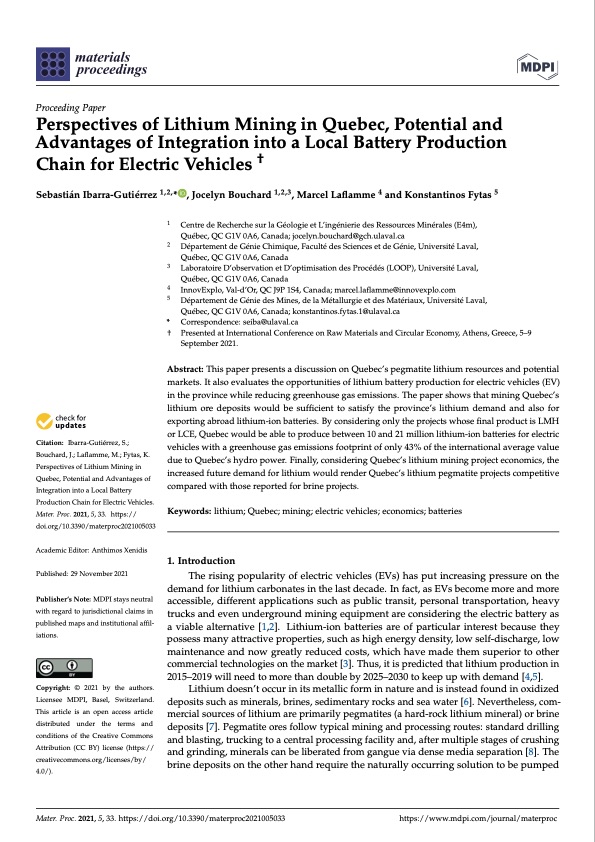
PDF Publication Title:
Text from PDF Page: 001
Proceeding Paper Perspectives of Lithium Mining in Quebec, Potential and Advantages of Integration into a Local Battery Production Chain for Electric Vehicles † Sebastián Ibarra-Gutiérrez 1,2,* 1 , Jocelyn Bouchard 1,2,3, Marcel Laflamme 4 and Konstantinos Fytas 5 Centre de Recherche sur la Géologie et L’ingénierie des Ressources Minérales (E4m), Québec, QC G1V 0A6, Canada; jocelyn.bouchard@gch.ulaval.ca Département de Génie Chimique, Faculté des Sciences et de Génie, Université Laval, Québec, QC G1V 0A6, Canada Laboratoire D’observation et D’optimisation des Procédés (LOOP), Université Laval, Québec, QC G1V 0A6, Canada InnovExplo, Val-d’Or, QC J9P 1S4, Canada; marcel.laflamme@innovexplo.com Département de Génie des Mines, de la Métallurgie et des Matériaux, Université Laval, Québec, QC G1V 0A6, Canada; konstantinos.fytas.1@ulaval.ca Correspondence: seiba@ulaval.ca Presented at International Conference on Raw Materials and Circular Economy, Athens, Greece, 5–9 September 2021. Abstract: This paper presents a discussion on Quebec’s pegmatite lithium resources and potential markets. It also evaluates the opportunities of lithium battery production for electric vehicles (EV) in the province while reducing greenhouse gas emissions. The paper shows that mining Quebec’s lithium ore deposits would be sufficient to satisfy the province’s lithium demand and also for exporting abroad lithium-ion batteries. By considering only the projects whose final product is LMH or LCE, Quebec would be able to produce between 10 and 21 million lithium-ion batteries for electric vehicles with a greenhouse gas emissions footprint of only 43% of the international average value due to Quebec’s hydro power. Finally, considering Quebec’s lithium mining project economics, the increased future demand for lithium would render Quebec’s lithium pegmatite projects competitive compared with those reported for brine projects. Keywords: lithium; Quebec; mining; electric vehicles; economics; batteries 1. Introduction The rising popularity of electric vehicles (EVs) has put increasing pressure on the demand for lithium carbonates in the last decade. In fact, as EVs become more and more accessible, different applications such as public transit, personal transportation, heavy trucks and even underground mining equipment are considering the electric battery as a viable alternative [1,2]. Lithium-ion batteries are of particular interest because they possess many attractive properties, such as high energy density, low self-discharge, low maintenance and now greatly reduced costs, which have made them superior to other commercial technologies on the market [3]. Thus, it is predicted that lithium production in 2015–2019 will need to more than double by 2025–2030 to keep up with demand [4,5]. Lithium doesn’t occur in its metallic form in nature and is instead found in oxidized deposits such as minerals, brines, sedimentary rocks and sea water [6]. Nevertheless, com- mercial sources of lithium are primarily pegmatites (a hard-rock lithium mineral) or brine deposits [7]. Pegmatite ores follow typical mining and processing routes: standard drilling and blasting, trucking to a central processing facility and, after multiple stages of crushing and grinding, minerals can be liberated from gangue via dense media separation [8]. The brine deposits on the other hand require the naturally occurring solution to be pumped Citation: Ibarra-Gutiérrez,S.; Bouchard, J.; Laflamme, M.; Fytas, K. Perspectives of Lithium Mining in Quebec, Potential and Advantages of Integration into a Local Battery Production Chain for Electric Vehicles. Mater.Proc.2021,5,33. https:// doi.org/10.3390/materproc2021005033 Academic Editor: Anthimos Xenidis Published: 29 November 2021 Publisher’s Note: MDPI stays neutral with regard to jurisdictional claims in published maps and institutional affil- iations. Copyright: © 2021 by the authors. Licensee MDPI, Basel, Switzerland. This article is an open access article distributed under the terms and conditions of the Creative Commons Attribution (CC BY) license (https:// creativecommons.org/licenses/by/ 4.0/). 2 3 4 5 * † Mater. Proc. 2021, 5, 33. https://doi.org/10.3390/materproc2021005033 https://www.mdpi.com/journal/materprocPDF Image | Perspectives of Lithium Mining in Quebec

PDF Search Title:
Perspectives of Lithium Mining in QuebecOriginal File Name Searched:
materproc-05-00033.pdfDIY PDF Search: Google It | Yahoo | Bing
Product and Development Focus for Infinity Turbine
ORC Waste Heat Turbine and ORC System Build Plans: All turbine plans are $10,000 each. This allows you to build a system and then consider licensing for production after you have completed and tested a unit.Redox Flow Battery Technology: With the advent of the new USA tax credits for producing and selling batteries ($35/kW) we are focussing on a simple flow battery using shipping containers as the modular electrolyte storage units with tax credits up to $140,000 per system. Our main focus is on the salt battery. This battery can be used for both thermal and electrical storage applications. We call it the Cogeneration Battery or Cogen Battery. One project is converting salt (brine) based water conditioners to simultaneously produce power. In addition, there are many opportunities to extract Lithium from brine (salt lakes, groundwater, and producer water).Salt water or brine are huge sources for lithium. Most of the worlds lithium is acquired from a brine source. It's even in seawater in a low concentration. Brine is also a byproduct of huge powerplants, which can now use that as an electrolyte and a huge flow battery (which allows storage at the source).We welcome any business and equipment inquiries, as well as licensing our turbines for manufacturing.| CONTACT TEL: 608-238-6001 Email: greg@infinityturbine.com | RSS | AMP |